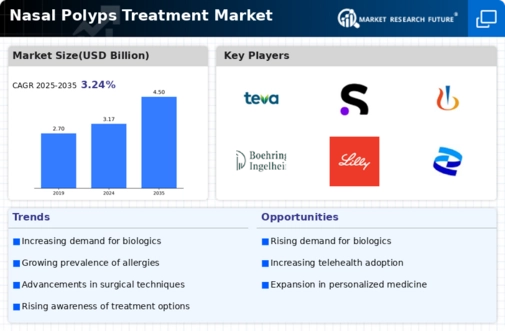The Nasal Polyps Treatment Market has witnessed considerable growth in recent years, mainly due to the increasing prevalence of nasal polyps alongside rising awareness regarding available treatment options. This market is highly competitive, characterized by the presence of several players who are continually innovating to enhance their product offerings. The treatment of nasal polyps primarily involves pharmacologic therapies, including corticosteroids, as well as surgical interventions for severe cases. Factors such as advancements in drug formulations, rising healthcare expenditures, and growing emphasis on research and development are shaping the competitive landscape.
Players in this market are striving to expand their presence globally while also adapting to changing regulatory frameworks and addressing the diverse needs of patients affected by this condition.Merck and Co. has established a robust presence in the Nasal Polyps Treatment Market, largely attributed to its strong research and development capabilities.
The company's focus on innovative therapies has led to the development of effective treatment options that cater specifically to the nasal polyp’s market. It has successfully positioned itself as a leader in this area by not only offering well-received medications but also by engaging in partnerships and collaborations aimed at expanding its product pipeline. The strategic advantage of Merck and Co. lies in its extensive clinical experience, comprehensive support networks for healthcare providers, and a favorable reputation among patients.
These strengths empower the company to maintain a competitive edge and effectively address the needs of individuals suffering from nasal polyps.Teva Pharmaceutical Industries has also made significant strides in the Nasal Polyps Treatment Market, driven by its commitment to delivering high-quality, affordable medications. Teva focuses on providing a wide range of treatments, which includes both branded and generic options, thereby catering to diverse patient needs and preferences.
The company’s emphasis on accessibility ensures that its products reach a broader population, highlighting their strengths in cost-effective solutions. In addition to competitive pricing, Teva Pharmaceutical Industries invests heavily in research and development to enhance its product offerings and improve patient outcomes. This focus on innovation, combined with a solid distribution network, enables the company to effectively compete in the market while addressing the ongoing challenges faced by patients with nasal polyps.




















